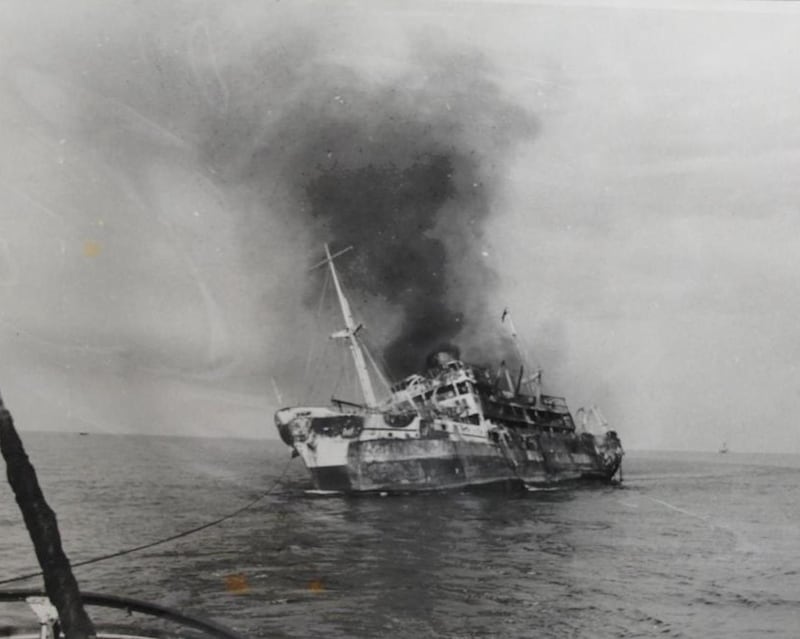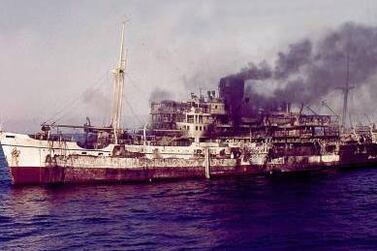In a flash of light, the explosion ripped through the deck of the SS Waingapoe, a Dutch ship sailing south from Muscat to Salalah.
Through luck, the only casualties were a crate of sewing machines and a motor car reported to belong to the Sultan.
It was three weeks later when a British official in Bahrain picked up a report of the Waingapoe incident, gathering dust on his desk, and read it with new interest.
Four days earlier an explosion on another ship had taken the lives of at least 240 men, women and children.
"I suggest that it strengthens the argument for drawing public attention to what appears to be a terrorist campaign, of which the Dara may well have been a victim," he wrote to his masters in London.
Sixty years ago today on April 8, 1961, the loss of the MV Dara, following an explosion and fire off the coast of Dubai, remains the worst peacetime maritime disaster in the modern history of the Gulf.
Several Dubai families still feel the pain of the loss suffered that night and the horrors they experienced before being rescued from the sea.
Yet the Dara disaster was far from an isolated incident. Indeed, with better security and intelligence, it might have been avoided.
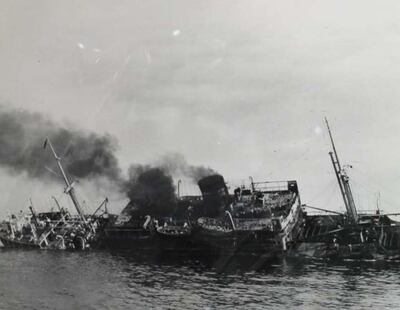
A public inquiry found the Dara fire had been started by a bomb, likely an anti-tank mine planted before the ship left port to ride out a storm. The same bad weather had delayed the ship's sailing. When it exploded, the Dara should have been sailing into Muscat harbour.
The suspected perpetrators were Omani insurgents engaged in a bloody conflict called the Jebel Akhdar War, named after the mountain where the rebels made their final stand in January 1959.
The war set the interior of Oman, ruled as an Imamate, against the coastal Sultanate of Muscat, and was triggered by the Sultan Said Bin Taimur allowing oil prospectors to push inland.
Britain had given considerable military support to the Sultan’s forces, so the rebels consider the UK and its interests in the region to be legitimate targets.
Defeated at home, between 1959 and 1962, the insurgents continued a sustained terrorist campaign in the Gulf, hitting not just the Dara but several sister ships in the British India Steam Navigation Company.
The disappearance of a passenger aircraft is suspected to have been caused by another explosion, while a separate flight escaped only because a bomb in a mail sack detonated before it was loaded.
Dubai was not spared. Over two nights from February 28, 1962, four small bombs exploded in the city, including one at the Political Agency, as the British Embassy was then called.
The first recorded attack took place on December 29, 1959 as the SS Dwarka, another BISN ship, sailed from Muscat to Bombay. The intended victim was the Sultan's minister of the interior, Ahmad ibn Ibrahim Al Bu Sa'idi.
He escaped with minor injuries when the bomb exploded in his first class cabin, apparently because at the last minute he had decided to sleep with his head at the other of the bed.
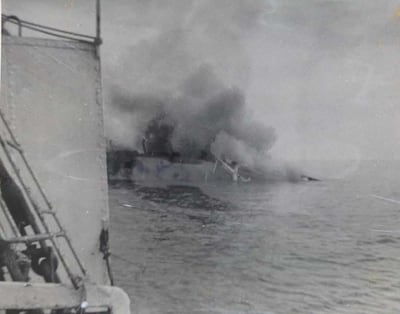
In all, the Dwarka would be attacked by terrorists three times. In June 1961, a plastic explosive device went off as the ship approached Muscat, injuring an elderly woman.
Finally, the ship was bombed again in October 1962 as it sailed from Dubai to Muscat on the Bahrain-Karachi route.
The London Daily Telegraph reported, "An explosion aboard the British India passenger-cargo ship Dwarka burned an Arab woman and child as the ship neared Muscat."
On examination in Bombay, the damage was found to be more serious than first thought. Better placed, the bomb would have sunk the Dwarka. A second tragedy on the scale of the Dara had only narrowly been avoided.
In May 1962, a bomb exploded inside a mail bag just before it was loaded on a Gulf Aviation flight leaving from Bahrain’s Muharraq airport.
A year earlier, another Gulf Aviation flight, a Douglas DC3 leased from India's Kalinga Airlines, vanished mid-air between Doha and Sharjah. All 13 passengers and three crew died.
One of the passengers was later discovered to have the same name as a well-known Omani rebel, says John Peterson, the historian and author of several books on the period.
“Intelligence sources indicated that a time bomb was placed on the plane and was intended to go off after the passengers disembarked at Sharjah. It seemed to have gone off prematurely, killing the perpetrators as well as everyone else aboard,” he says.
The mounting attacks caused growing alarm among the authorities. In a message to the UK foreign office in March 1962, A B Given, of the British India Steam Navigation officials in the Gulf, warned, “As you will undoubtedly know, there have been a number of bomb outrages in the Dubai area over the past few weeks, apparently directed in particular against British interests.”
The BISN operated four ships in the Gulf and Arabian Sea that were named after historic sites in the region. They were part of a larger fleet that carried passengers, freight and mail, and a vital transport link before air travel became common.
The Dara, Daressa, Dwarka, and Dwhova – popularly known as the "4 D's" – could carry up to a thousand passengers on their upper deck alone. Their customers were mostly labourers or low-income families moving between the Gulf States, India and Pakistan.
Many carried their possessions in multiple boxes or cloth bundles. Some brought camping stoves to prepare food during the voyage. It was, in short, a security nightmare.
In September 1962, it was the turn of the Daressa, when a small bomb detonated on board shortly after it left Dubai; however, there were no casualties.
The Daressa attack did at least produce a suspect, named as Sulman Juma Abdul Hai and travelling on a Palestinian passport. Abdul Hai had sailed from Dubai to Kuwait on the Daressa but was denied entry because he did not have a visa.
Making his way to Bahrain on another ship, Abdul Hai was briefly detained because of passport irregularities. Finally identified as a person of interest in the bombing, it turned out he had already been deported to Saudi Arabia.
With four attacks on its ships, the shipping line seriously began to think of dropping some Gulf ports from its regular itinerary, hoping to confuse the terrorists.
The idea was scrapped, along with another proposal to put soldiers on sailings or provide Royal Navy escorts. “Our first reaction is that such a change would admit our inability to cope with Omani sabotage,” an official explained.
The problem amounted to an enemy, skilled in the arts of guerrilla warfare from the Jebel Akhdar campaign, and supported with materials and refuge by co-conspirators in Iraq, Egypt and Saudi Arabia.
A breakthrough came with the final attack on the Dwarka. Intelligence identified a suspect named as Khamis bin Markhoun Mola Beni Hiria, who had been detained by the Trucial Oman Scouts in Dubai.
Hiria was already known in Muscat, where he was accused of “mining” or planting roadside bombs.
He was found to be carrying documents belonging to a Mohamed Said, who had travelled on the Dwarka on an Ajman passport but disembarked the ship in Dubai just before the explosion.
After a short debate about the legitimacy of doing so, the Trucial Oman Scouts handed the suspect to the Sultan’s Armed Forces where - perhaps unsurprisingly - he made a full confession.
The statement, in Arabic with an English translation, survives. Originally from the mountain village of Balad Sait, Hiria had been living in Dammam in Saudi Arabia for five years, serving in the army of the Iman's brother Ghalib, who was living there in exile.
Sent to Qatar, he met a man who gave “some objects to me and also some instructions as what I had to do with them.”
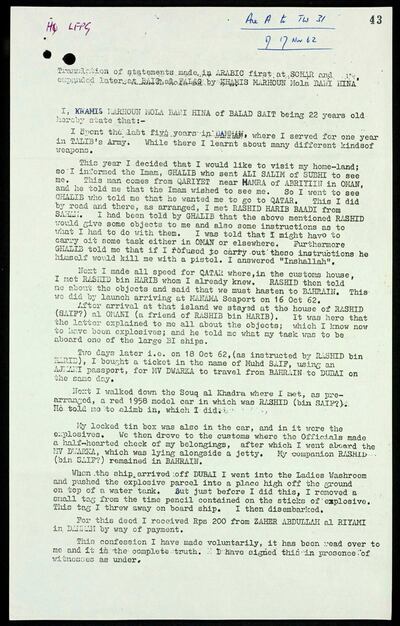
Journeying on to Bahrain, there was another rendezvous where it was explained the “objects” were explosives to be taken on board a BISN ship.
After a "half-hearted check of my belongings" Hiria boarded the Dwarka. "When the ship arrived off Dubai I went to the ladies washroom and pushed the explosive parcel into a place high off the ground….just before I did this I removed the small tag from the time pencil."
Hiria, who was 22, added he had been paid 200 Gulf rupees for the mission, or about Dh70 in today’s money. His fate is not recorded but it was likely the death sentence and a public execution.
“I personally should be loth to plead for this man’s life in view of the exceptionally dastardly nature of his crime,” a British official wrote to London.
No one was ever arrested for the Dara bombing, although five months later a dhow was intercepted carrying around a dozen members of the Oman Revolutionary Movement.
“There seems little doubt that all of these acts were carried out by ORM members directed from the ORM in Dammam”, says Peterson. “It is impossible to say how many but we are probably talking about two or three dozen.”
The Dwarka was the last BISN line ship to be bombed and marked the end of the terrorist campaign in the Gulf, although attacks continued in Oman and tensions remained high for several years.
Bill Wright was hired by the company as a ship’s security officer in 1965, after first being vetted by the British intelligence service MI5 and trained in identifying explosives.
Posted to the SS Dumra and later Sirhana, he "rapidly concluded that a determined individual would have no trouble in smuggling a device onto the ship."
“The task of the security officer was impossible,” he said. “I believe that the idea of carrying a security officer was simply to comply with the requirements of Lloyd’s of London, the maritime insurers.”
Wright, who now lives in New Zealand, last saw Dubai around 1969. As he sailed out, the masts, funnel and some of the superstructure of the doomed Dara were still visible above the water.
